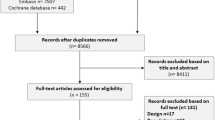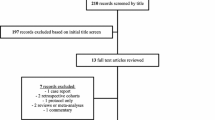Abstract
Purpose
Benzodiazepines are effective medicines for insomnia and anxiety but are commonly used beyond recommended treatment time frames, which may lead to adverse drug events. The aim of this systematic review was to critically evaluate the success of interventions used to reduce benzodiazepines and ‘Z-drug’ use, and the impact of these interventions on clinical outcomes in older adults.
Methods
A search was conducted in PubMed, Embase, Informit, International Pharmaceutical Abstracts, Scopus, PsychINFO, Cochrane Central Register of Controlled Trials (CENTRAL) and CINAHL. Studies conducted in older adults (≥65 years) and published between January 1995 and July 2015 were included. Two authors independently reviewed all articles for eligibility and extracted the data.
Results
Seven studies of benzodiazepines and Z-drug withdrawal were identified. Benzodiazepine discontinuation rates were 64.3% in one study that employed pharmacological substitution with melatonin and 65.0% in a study that employed general practitioner-targeted intervention. Mixed interventions including patient education and tapering (n = 2), pharmacological substitution with psychological support (n = 1) and tapering with psychological support (n = 1) yielded discontinuation rates between 27.0 and 80.0%. Five studies measured clinical outcomes following benzodiazepine discontinuation. Most (n = 4) observed no difference in prevalence of withdrawal symptoms or sleep quality, while one study reported decline in quality of life in those who continued taking benzodiazepine vs. those who discontinued over 8 months.
Conclusions
Current evidence shows that benzodiazepine withdrawal is feasible in the older population, but withdrawal rates vary according to the type of intervention. As the benefits and sustainability of these interventions are unclear, further studies should be conducted to assess this.

Similar content being viewed by others
References
(2016) Australian medicines handbook. In: ed. Australian medicines handbook
Cumming RG, Le Conteur DG (2003) Benzodiazepines and risk of hip fractures in older people. CNS Drugs 17(11):825–837
Lader M (2011) Benzodiazepines revisited—will we ever learn? Addiction 106(12):2086–2109
Kruse WH (1990) Problems and pitfalls in the use of benzodiazepines in the elderly. Drug Saf 5(5):328–344
de Gage SB, Moride Y, Ducruet T, Kurth T, Verdoux H, Tournier M, Pariente A, Bégaud B (2014) Benzodiazepine use and risk of Alzheimer’s disease: case-control study. BMJ 349:g5205
Yaffe K, Boustani M (2014) Benzodiazepines and risk of Alzheimer’s disease. BMJ 349:5312
Buysse DJ, Reynolds CF (2000) Pharmacologic treatment. In: Lichstein KL, Morin CM (eds) Treatment of late-life insomnia. Sage Publications, Thousand Oaks-London-New Delhi, pp 231–267
Windle A, Elliot E, Duszynski K, Moore V (2007) Benzodiazepine prescribing in elderly Australian general practice patients. Aust N Z J Public Health 31(4):379–381
Smith AJ, Tett SE (2009) How do different age groups use benzodiazepines and antidepressants? Analysis of an Australian administrative database, 2003-6. Drugs Aging 26(2):113–122. doi:10.2165/0002512-200926020-00003
Paulose-Ram R, Safran MA, Jonas BS, Gu Q, Orwig D (2007) Trends in psychotropic medication use among US adults. Pharmacoepidemiol Drug Saf 16(5):560–570
Donoghue J, Lader M (2010) Usage of benzodiazepines: a review. Int J Psychiatry Clin Pract 14(2):78–87
Hoffmann F (2013) Perceptions of German GPs on benefits and risks of benzodiazepines and Z-drugs. Swiss Med Wkly 143:w13745
Islam MM, Conigrave KM, Day CA, Nguyen Y, Haber PS (2014) Twenty-year trends in benzodiazepine dispensing in the Australian population. Intern Med J 44(1):57–64. doi:10.1111/imj.12315
Siriwardena AN, Qureshi Z, Gibson S, Collier S, Latham M (2006) GPs’ attitudes to benzodiazepine and ‘Z-drug’ prescribing: a barrier to implementation of evidence and guidance on hypnotics. Br J Gen Pract 56(533):964–967
Brett J, Murnion B (2015) Management of benzodiazepine misuse and dependence. Aust Prescr 38(5):152–155
Olfson M, King M, Schoenbaum M (2015) Benzodiazepine use in the United States. JAMA Psychiatry 72(2):136–142. doi:10.1001/jamapsychiatry.2014.1763
van Hulten R, Isacson D, Bakker A, Leufkens HG (2003) Comparing patterns of long-term benzodiazepine use between a Dutch and a Swedish community. Pharmacoepidemiol Drug Saf 12(1):49–53. doi:10.1002/pds.784
Llorente MD, David D, Golden AG, Silverman MA (2000) Defining patterns of benzodiazepine use in older adults. J Geriatr Psychiatry Neurol 13(3):150–160
Alvarenga JM, Loyola Filho AI, Firmo JO, Lima-Costa MF, Uchoa E (2008) Prevalence and sociodemographic characteristics associated with benzodiazepines use among community dwelling older adults: the Bambui Health and Aging Study (BHAS). Rev Bras Psiquiatr 30(1):7–11
Jorm AF, Grayson D, Creasey H, Waite L, Broe GA (2000) Long-term benzodiazepine use by elderly people living in the community. Aust N Z J Public Health 24(1):7–10
Westbury JL, Jackson S, Peterson GM (2010) Psycholeptic use in aged care homes in Tasmania, Australia. J Clin Pharm Ther 35(2):189–193. doi:10.1111/j.1365-2710.2009.01079.x
Salzman C, Fisher J, Nobel K, Glassman R, Wolfson A, Kelley M (1992) Cognitive improvement following benzodiazepine discontinuation in elderly nursing home residents. Int J Geriatr Psychiatry 7:89–93
Reeve E, Gnjidic D, Long J, Hilmer S (2015) A systematic review of the emerging definition of “deprescribing” with network analysis: implications for future research and clinical practice. Br J Clin Pharmacol 80(6):1254–1268
Alldred DP (2014) Deprescribing: a brave new word? Int J Pharm Pract 22(1):2–3
Le Couteur DG, Banks E, Gnjidic D, McLachlan A (2011) Deprescribing. Aust Prescr 34(6):182–185
Reeve E, Shakib S, Hendrix I, Roberts MS, Wiese MD (2014) The benefits and harms of deprescribing. Med J Aust 201(7):386–389. doi:10.5694/mja13.00200
Gnjidic D, Le Couteur DG, Hilmer SN (2014) Discontinuing drug treatments. BMJ 349:g7013
Pollmann AS, Murphy AL, Bergman JC, Gardner DM (2015) Deprescribing benzodiazepines and Z-drugs in community-dwelling adults: a scoping review. BMC Pharmacol Toxicol 16:19. doi:10.1186/s40360-015-0019-8
Gould RL, Coulson MC, Patel N, Highton-Williamson E, Howard RJ (2014) Interventions for reducing benzodiazepine use in older people: meta-analysis of randomised controlled trials. Br J Psychiatry 204(2):98–107. doi:10.1192/bjp.bp.113.126003
Moher D, Liberati A, Tetzlaff J, Altman DG (2010) Preferred reporting items for systematic reviews and meta-analyses: the PRISMA statement. Int J Surg 8(5):336–341. doi:10.1016/j.ijsu.2010.02.007
Higgins JP, Altman DG, Gotzsche PC, Juni P, Moher D, Oxman AD, Savovic J, Schulz KF, Weeks L, Sterne JA (2011) The Cochrane Collaboration’s tool for assessing risk of bias in randomised trials. BMJ 343:d5928. doi:10.1136/bmj.d5928
Bourgeois J, Elseviers MM, Van Bortel L, Petrovic M, Stichele RHV (2014) Feasibility of discontinuing chronic benzodiazepine use in nursing home residents: a pilot study. Eur J Clin Pharmacol 70(10):1251–1260
Garzon C, Guerrero JM, Aramburu O, Guzman T (2009) Effect of melatonin administration on sleep, behavioral disorders and hypnotic drug discontinuation in the elderly: a randomized, double-blind, placebo-controlled study. Aging Clin Exp Res 21(1):38–42
Petrovic M, Pevernagie D, Van Den Noortgate N, Mariman A, Michielsen W, Afschrift M (1999) A program for short-term withdrawal from benzodiazepines in geriatric hospital inpatients: success rate and effect on subjective sleep quality. Int J Geriatr Psychiatry 14(9):754–760. doi:10.1002/(SICI)1099-1166(199909)14:9<754::AID-GPS15>3.0.CO;2-E
Petrovic M, Pevernagie D, Mariman A, Van Maele G, Afschrift M (2002) Fast withdrawal from benzodiazepines in geriatric inpatients: a randomised double-blind, placebo-controlled trial. Eur J Clin Pharmacol 57(11):759–764. doi:10.1007/s00228-001-0387-4
Salonoja M, Salminen M, Aarnio P, Vahlberg T, Kivela SL (2010) One-time counselling decreases the use of benzodiazepines and related drugs among community-dwelling older persons. Age Ageing 39(3):313–319
Tannenbaum C, Martin P, Tamblyn R, Benedetti A, Ahmed S (2014) Reduction of inappropriate benzodiazepine prescriptions among older adults through direct patient education: the EMPOWER cluster randomized trial. JAMA Intern Med. doi:10.1001/jamainternmed.2014.949
Curran H, Collins R, Fletcher S, Kee S, Woods B, Iliffe S (2003) Older adults and withdrawal from benzodiazepine hypnotics in general practice: effects on cognitive function, sleep, mood and quality of life. Psychol Med 33(7):1223–1237
Martin P, Tamblyn R, Ahmed S, Benedetti A, Tannenbaum C (2015) A consumer-targeted, pharmacist-led, educational intervention to reduce inappropriate medication use in community older adults (D-PRESCRIBE trial): study protocol for a cluster randomized controlled trial. Trials 16:266. doi:10.1186/s13063-015-0791-1
Westbury J, Jackson S, Gee P, Peterson G (2010) An effective approach to decrease antipsychotic and benzodiazepine use in nursing homes: the RedUSe project. Int Psychogeriatrics 22(1):26–36. doi:10.1017/S1041610209991128
Lopez-Peig C, Mundet X, Casabella B, del Val JL, Lacasta D, Diogene E (2012) Analysis of benzodiazepine withdrawal program managed by primary care nurses in Spain. BMC Res Notes 5:684. doi:10.1186/1756-0500-5-684
Salzman C, Shader RI (2015) Not again: benzodiazepines once more under attack. J Clin Psychopharmacol 35(5):493–495. doi:10.1097/jcp.0000000000000383
Author information
Authors and Affiliations
Contributions
ER was involved in the conception and design of the work, supervised screening and data extraction, conducted quality assessment, was involved in drafting and revising the manuscript for important intellectual content and approved the final version.
MO was involved in the conception and design of the work, conducted screening of abstracts and data extraction, drafted the manuscript and approved the final version.
AW was involved in the conception and design of the work, conducted screening of abstracts and data extraction, reviewed the manuscript and approved the final version.
JJ was involved in the conception and design of the work, reviewed the manuscript critically for important intellectual content and approved the final version.
MP was involved in the conception and design of the work, reviewed the manuscript critically for important intellectual content and approved the final version.
DG was involved in the conception and design of the work, supervised screening and data extraction, was involved in drafting and revising the manuscript for important intellectual content and approved the final version.
Corresponding author
Ethics declarations
Conflict of interest
The authors declare that they have no competing interests.
Funding
None.
Rights and permissions
About this article
Cite this article
Reeve, E., Ong, M., Wu, A. et al. A systematic review of interventions to deprescribe benzodiazepines and other hypnotics among older people. Eur J Clin Pharmacol 73, 927–935 (2017). https://doi.org/10.1007/s00228-017-2257-8
Received:
Accepted:
Published:
Issue Date:
DOI: https://doi.org/10.1007/s00228-017-2257-8




